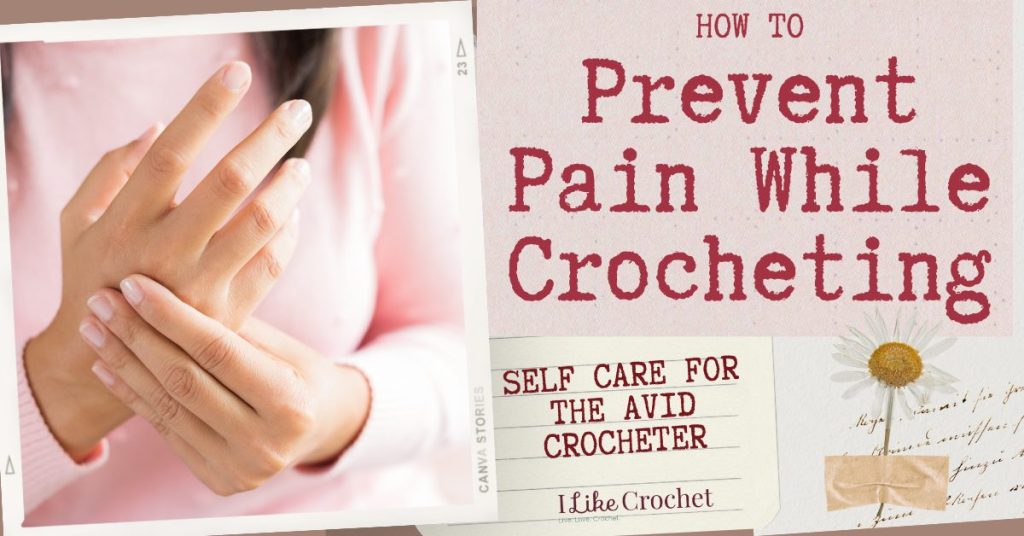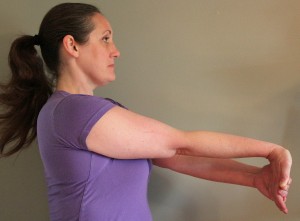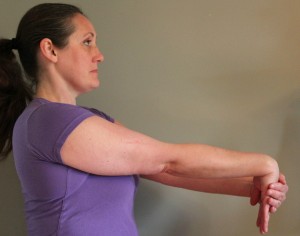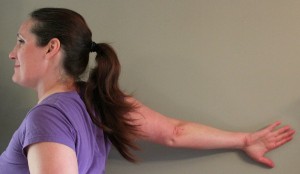
Repetitive and calming, crocheting can be a very effective way to de-stress, wind down and soothe your soul after a hectic day. Over time, however, you may develop pains resulting from the very thing that is soothing about crochet, its repetitiveness. Unfortunately, pain is something that yarn crafters deal with from time to time. Repetitive motions in the hands and/or wrists can often cause cramping or sharp pains that make it hard to finish that big project! Luckily, a lot of pain can be avoided or alleviated with some basic adjustments to your form, posture and tools.
Common Repetitive Strain Injuries (RSI’s) in crocheters are headaches, neck or upper back pain, hand or wrist pain and tendinitis in the elbow and/or shoulder.
Something to really keep in mind is that any pain while crocheting may be a sign of a Repetitive Strain Injury, which makes up nearly two thirds of occupational illnesses according to the US Bureau of Labor Statistics. The folks at RSI-Therapy.com recommend limiting time spent on a certain job to one hour or less to help prevent these types of strains. Remind yourself to take plenty of breaks to allow your body to experience different types of movement.
Luckily RSI’s, are easily managed or prevented by practicing the following tips and exercises regularly:
- Take short breaks often. If watching TV, get up, walk around, do some of the following exercises during commercials. If not, set your phone for a timer every 15 -20 minutes and take a mini-break.
- Make sure you have good lighting.
- Change the project you are working on. Cottons, linens and bamboo fibers have very little give and cause strain on your arms when working with them. Limit your time working with these fibers. Switch to another project that uses ‘springier’ yarns (blends, wools, acrylics, etc.).
- Try loosening your grip on your hook and sitting up straight. When teaching, I find that pain complaints can be stopped when we adjust the hunched-over-death grip that nervous students take on the hooks. Your grip should be firm but flexible. If someone pulled on your hook, it should come free easily. No white knuckle crocheting.
Headaches, Neck, Shoulder and Upper Back Pain
Headaches and neck pain after crocheting are usually caused by one of two things, eye strain and neck or upper back strain.
Good lighting is the easiest way to prevent eye strain. Also, by contrasting the background to the yarn you are using, it ensures an easier time seeing your stitches. For example, if you are working with dark colors, drape a light or white cloth or towel across your lap to provide a contrast your yarn.
Neck and upper back pain results from looking down at your work either for long periods or repetitively. During your mini-break, relieve neck tension by flexing your head from side to side (ear towards your shoulder keeping your shoulders down) then forward and back (chin to chest then looking up) 5 times in each direction. To relieve shoulder and upper back tension, roll your shoulders forwards and backwards 5 times in each direction then squeeze your shoulder blades together tightly, count to 10 then relax for a count of 20, repeat 3 times.
“Firstly I make sure to sit comfortably with a good support for my back, put a pillow under my arm when the project is getting heavy, and get a break regularly to stretch my arms, neck, and shoulders. Also, good ergonomic hook is definitely worth it.” – Adinda Hening
Shoulder or Elbow Tendinitis, Wrist or Hand Pain
If you have pain that comes and goes in your shoulder, elbow, wrist or hands or that gets worse while crocheting, you might have developed tendinitis at one or more of your joints. By following these simple exercises, you can relieve your pain and prevent worsening of your symptoms.
If you think you need additional support, there are some really great support gloves on the market that you can wear while working on your project. They provide some compression and help with swelling. The Crochet Dude has a great line of different styles available at Michael’s and JoAnn’s. I wear them when I know I’ll be sitting for a while (deadlines can be brutal sometimes) or if I am working on a heavy piece.
“I always place a pillow under my arm. It helps a lot in preventing pain in my shoulders. Also, I wear craft gloves when knitting/crochet.” – Nazanin Fard
Also, is the piece you’re working on large and cumbersome, like an afghan or an adult sweater, perhaps? If so, make sure you’re working somewhere where you can place the item to help hold the weight rather than letting it just hang down, putting all the weight on your wrists. When I am working on a big item, I will often find a comfortable chair at a table or place a pillow in my lap to help manage the weight.
Note: If you experience pain all the time, if it wakes you up at night or you can’t sleep due to the pain, see your doctor. It may not be tendinitis or your tendinitis might need medical intervention to resolve the pain.
- Elbow stretch for “Golfers Elbow”: Hold your arm straight out in front of you, palm facing up. With your other hand, gently press your hand down so your fingers point to the floor. Hold the stretch for at least 30 seconds, slowly release and repeat for other arm.

- Elbow stretch for “Tennis Elbow”: Hold your arm straight out in front of you, palm facing down. With your other hand, gently press your hand down so your fingers point to the floor. Hold the stretch for at least 30 seconds, slowly release and repeat for other arm.

- Shoulder Tendonitis (“Biceps Tendonitis”): Standing sideways with your sore shoulder side to a wall, with the back of your hand flat on the wall and thumb pointing down, slowly bring your arm up behind you along the wall. Only bring your arm up as high as you can to feel the stretch in the front of your shoulder and upper arm. Hold 30 seconds and slowly release.

Note of caution: Stretching should NOT be painful! If it hurts, you are over-stretching and your pain will worsen. Relax until you only feel the stretch with no pain and then hold.
“Stretch hands, arms, and shoulders before working, use good ergonomic hooks, and use Epsom salt soaks to reduce swelling when you have been working for a long time.” – Kati Brown
You can also try a few gentle stretches before working and at break periods throughout your session. One that I find really helpful is something I like to call the “Yarn Prayer” followed by the “Motorcycle Stretch.”
- Sit tall and place your hands together in front of your chest, as if you are about to pray. Press them together firmly from wrist to fingertips.
- Slowly press one hand into the other so the other flexes backward. Hold for a count of ten and switch. Do this a few times with deep breaths.
- While still holding that prayer form, rotate hands outwards to make fingertips point into the room. Hold for a count of ten and then rotate back to upright.
- Next, rotate so that your fingertips are now pointing inwards. Hold for a count of ten.
- Move your hands apart and forward from your body, palms down, and make fists (not tight). While keeping your arms straight, rotate your wrists to point your fists away from your body, holding for 10 seconds. You’ll really feel this one in your forearms!
- Finally, drop your hands to your side and shake them out. A few shoulder shrug rolls will probably feel good at this point as well
Wrist and Hand Pain
Tightly squeeze your hands into fists, rotate wrists one direction 5 times. Next, alternately widely open your fingers then squeeze tightly together into fists, repeating 5 times. With your fists squeezed, rotate your wrists the opposite way 5 times. Finally, repeat the flicking-squeezing motion of your hands 5 times. Shake out your wrists and hands.
“Hand stretches – mostly clenching fist and stretching fingers.” – Emma Wilkinson
All these simple exercises and tips take no more than a few minutes to complete and will save you a lot of missed crochet time in the long run. By taking care of yourself, crochet will to continue to be the relaxing and soothing activity you have come to enjoy for your many future projects.
If you’re experiencing a great deal of pain (especially sharp, stabbing pains), I would definitely suggest a visit to your doctor. You may have something else going on, such as carpal tunnel, and might benefit from physical therapy. Don’t forget: ice and Aleve are your friends!
Hooks
If you haven’t experienced pain while crocheting yet and/or want to prevent future injuries, investing in the right tools from the start is a good idea. While some of the prettiest and unique hooks on the market are also at a higher price point, many are worth it for the comfort alone. It does take some time to find the type of hook that works best for you as each crocheter has their own way of holding their hook. Here’s what some of our designers have to say:
“A good ergonomic hook like Clover brand is worth its weight in gold!” – Susan Kennedy
“I use to have pain in my wrists when i would crochet all day. ever since I changed to Clover Amour crochet hooks, I do not have that problem and more…even when I am crocheting with multiple strands of yarn!” – Debra Arch
“Using ergonomic wooden hooks and lots of breaks to stretch arms and hands!” – Tanya Eberhardt
“I have three hooks in each size which all require a different grip. I rotate them throughout the day and that works well for me. I also keep a few rubber bands in my bag which I can use to wrap smaller hooks so I don’t have to hold them as tight. I also crochet with both hands and find that helps too” – Rosann Fleischauer
Personally, I would recommend buying an ergonomic hook in the size that you use the most to test out how it feels instead of buying a whole set of hooks that you may not like. Many crocheters seek out ergonomic hooks AFTER having an injury, but if you’re starting out I encourage you to seek out these friendlier hooks from the beginning.
Do you have additional tips, tricks, stretches and more to add to this article? Share your thoughts in the comments below!
This article combines expertise from past articles by Beth Major and Chris Hammond with additional quotes from our designers.



Thank you for this article – such great information and picture demonstrations. All the comments were great too. This is also a great reminder to take breaks – just like when working at a desk job – and to stretch and breathe. The body doesn’t like being in one position continuously – we need movement.
This is a fantastic article full of good information and instruction. I too would love this in pdf to print as another had mentioned. Although the comments hold good suggestions too.
Again, Thank you!!
Thank you Nicola for this timely and timeless article. I suggest that you consider making this article downloadable so we can access it again when needed. Christmas is coming soon and many of us are crocheting gifts and projects that require more than one hour at a time. Just saying.
Great ideas I myself get numbness in my little finger the one doing the crochet hook so
bad I can’t carry in.
Make toys and at 86 gives me something to do. Any ideas about this problem?
When my wrist was stiff, sore and swollen for ages I finally went to a hand specialist and was diagnosed with Kienböck’s disease. It happens when the blood supply to the bones gets interrupted and they die. It’s rare, it only shows up in around seven out of every 100,000 wrist scans so your GP or even Orthopedic doctor might not think of it. I didn’t understand that a hand specialist was different from an orthopod so when all he offered was a cortisone shot I passed. Two years later I told my doctor how my wrist just gets worse everyday so he referred me to the hand specialist. Treatment is a simple surgery to remove the dead bone and fortunately the cartilage in my wrist is good and there’s no arthritis so I’m a good candidate for surgical treatment. Most important is that I can still crochet! Kienbock’s disease isn’t uncommon or hard to treat for a hand specialist so if you have pain, stiffness, swelling and all you’re offered is a cortisone shot, see a hand specialist.
Sometimes a cortisone shot given by a hand specialist is all you need.
Thank you
I wrap several layers of narrow self adhesve elastic bandage, not the sticky kind, around the center of thin hooks creating a larger grip surface. If the bandage gets dirty or frayed, simply remove it. This helps tremendously.
Great idea – thanks!
Thank you so much for this article. I do tend to get stuck in to the work and stay on something for hours at a time, especially at night after the kids are in bed. Comments from others have also been fantastically helpful 🙂
Thank you for the information and exercises. I will use them in my work.
I have de quervain’s tenosynovitis. Anyone else have that and what do you do for it?
I have it and I wear a brace when crotcheting that I got on Amazon. If you put quervain in the search plenty options, come up.
I splinted the trigger finger at night for about three months and. It hasn’t returned. That was about nine months ago
Great advice and exercises. I will be trying all of the above!
For the trigger thumb, I have had that and an injection of a steroid by my doctor fixed it and it never came back. Trigger fingers rarely go away on their own. Sometimes the shots don’t work or are ineffective after a while and surgery is required. I’ve never had the surgery but I know people who have and they say it really helped.
A shot of cortisone will help the trigger finger
My left thumb hurts from holding the fabric, any advise for that? I’m tight handed
A shot of cortisone will help the trigger finger
Thanks
Thank you for that article,very helpful. I have arthritis in my fingers, wrists. My fingers locks up and what I find that helps is like you all say is brake often, stretches. I keep lotion in my tote and when taking brakes I put lotion on and massage. I sometimes have to tape my thumb and index finger together and wrap my wrist with my brace.for a few days . I hope this does not stop me of crocheting when I’m a little older. I will look into those fingerless gloves and see if that helps , does anyone else have this problem; and have any helpful ideas.
Hi Laurie.
I also have arthritis in my thumb joint, wrists and starting in my fingers. I prefer to wear compression gloves while crocheting which helps with the pain and strain. I also use rapidgel when it’s too painful. I also use masking tape around my pinkies to avoid cramping. Compression gloves are available on ebay, it might help. 🙂
Jes
I found paraffin wax treatments help too. It helps with the pain besides softening your hands. Thanks for the great article.
Excellent exercises, thank you for them!
Thank you for this helpful advise.
Thanks! Great tips and exercises that I had not seen previously. I highly recommend fingerless compression gloves, they really make a difference, allowing me to work for longer stretches of time. Likewise, ergonomic, padded hooks (I love the ones that are flat in the middle of the shaft) help prevent the “death grip” required with plain metal hooks that can be slippery. I have bookmarked this page!
I found that holding each finger down with my thumb and stretching the rest up gives me a good stretch. The thumb is stretched by holding all four fingers straight up and the thumb is crossed against my palm (like showing a number 4 with your fingers).
Thanks, I appreciate the stretches.
I found my finger was getting quite sore so I bought some gel finger shields. Best thing I ever bought
Hi Vicky, are you referring to gel finger cots that completely cover the end of the finger, as well as the upper 2 joints, or gel finger sleeves that are tubes (do not cover the tip). Thank you very kindly! Barbara
thank you both, I will look out for those
Thank you for this article. It’s well done with sound advice.
Has anyone experienced pain in a thumb? I’ve developed “trigger finger” in my thumb, and wonder if it relates to my crocheting… The joint furthest out “locks” and is painful…. I’ve worn a thumb splint over the past few days, but can’t do anything with the splint on…. 🙁
I thought I was the only one; I too am looking for a solution. I would have to tape my thumb and index finger together for a few days. What I have been doing which works is I put some lotion on and massage my fingers,hand,and wrists,do some light stretches. I hope this helps and good luck.
Yes, I had trigger thumb in both thumbs several years ago. I recently had trigger finger in my right pinkie. I am always typing or crafting and that has caused the repetitive stress injuries in spite of using ergonomic hooks, exercises, etc . The thumbs and finger curled up into claws and would only open with clicks, especially at night and after waking up in the morning. They could be very painful. I had to have cortisone shots in my hands in all 3 cases to solve the problem. The doctor I recently saw said taping your fingers together with first aid tape works just as well as a splint for keeping your fingers straight while sleeping and can help prevent further incidences.
Hi, I have thumb pain also. I found some silicon thumb braces on Amazon. They wear like gloves but only encase and support the thumb and wrist. You can crochet while wearing them. Eases the cramp. Hope this helps you.
The exercises should help strengthen.
I have arthritis in my thumb joint and found compression gloves very helpful but I also use a thumb joint brace often. These are available at the pharmacy or online. I have found the best brand to Futuro which have splints you can put in and take out as needed
Thank you for the articles especially this one I have RA and osteoarthritis especially in my hands and am worried that I won’t be able to crochet anymore. I already cannot play the piano.
Great information and demonstration if exercises. I plan to adapt them to my exercise program. Thanks for sharing.